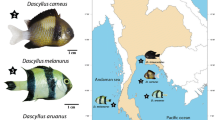Abstract
C-banding analysis with 47 gibbons of the subgenus Hylobates (Hylobates) (44-chromosome gibbons) uncovered that the gibbons had a characteristic complicated C-banding pattern. The C-band pattern also revealed that a whole-arm translocation (WAT) between chromosomes 8 and 9 existed only in the species H. agilis (agile gibbon). Comprehensive consideration allows postulation that the translocation seemed to be restricted to two subspecies: H. agilis agilis (mountain agile gibbon) and H. agilis unko (lowland agile gibbon), found in Sumatra and part of the Malay Peninsula. Moreover, combined intensive analyses of C-banding and chromosome painting provided strong evidence for a plausible evolutionary pathway of chromosome differentiation of chromosomes 8 and 9. The C-banded morph 8Mt/c seemed to be the primary type of chromosome 8 in the subgenus and to have altered into the three morphs through three pericentric inversions. The newest morph (8AM/ci) produced by the third inversion exchanged the long arm for chromosome 9, and subsequently constructed the WAT morphs of 8/9AMc/ct and 9/8Mi/ci.
Similar content being viewed by others
References
Ballou J, Ralls K( 1982) Inbreeding and juvenile mortality in small populations of ungulates: a detailed analysis. Biol Conserv 24: 239-272.
Benirschke K, Kumamoto AT (1991) Mammalian cytogenetics and conservation of species. J Hered 82: 187-191.
Geissman T (1995) Gibbon systematics and species identification. Int Zoo News 42: 467-501.
Groves C (2001) Primate Taxonomy.Washington: Smithsonian Institution Press.
Hirai H (2001) Relationship of telomere sequence and constitutive heterochromatin in the human and apes as detected by PRINS. Meth Cell Sci 23: 29-35.
Hirai H, Hasegawa Y, Kawamoto Y, Tokita E (1998) Tandem duplication of nucleolus organizer region (NOR) in the Japanese macaque, Macaca fuscata fuscata. Chromosome Res 6: 191-197.
Hirai H, Taguchi T, Godwin AK(1999) Genomic differentiation of 18S ribosomal DNA and β-satellite DNA in the hominoid and its evolutionary aspects. Chromosome Res 7: 531-540.
Hirai H, Hirai Y, Kawamoto Y, Endo H, Kimura J, Rerkamnuaychoke W (2002) Cytogenetic differentiation of two sympatric tree shrew taxa found in the southern part of the Isthmus of Kra. Chromosome Res 10: 313-327.
Imai HT (1991) Mutability of constitutive heterochromatin (C-bands) during eukaryotic chromosome evolution and their cytological meaning. Jpn J Genet 66: 635-661.
Imai HT, Satta Y, Takahata N (2001) Integrative study on chromosome evolution of mammals, ants and wasps based on the minimum interaction theory. J Theor Biol 210: 475-497.
Jauch A, Weinberg J, Stanyon R et al. (1992) Reconstruction of genomic rearrangements in great apes and gibbons by chromosome painting. Proc Natl Acad Sci USA 89: 8611-8615.
Koehler U, Arnold N, Wienberg J, Tofanelli S, Stanyon R (1995) Genomic reorganization and disrupted chromosomal synteny in the siamang (Hylobates syndactylus) revealed by fluorescence in situ hybridization. Am J Phys Anthropol 97: 37-47.
Kunze B, Weichenhan D, Virks P, Traut W, Winking H (1996) Copy numbers of a clustered long-range repeat determine C-band staining. Ctyogenet Cell Genet 73: 86-91.
Lande R (1979) Effective deme sizes during long-term evolution estimated from rates of chromosomal rearrangement. Evolution 33: 234-251.
Marshall J, Sugardjito J (1986) Gibbon systematics. In: Swindler DR, Erwin J, eds. Comparative Primate Biology, Vol. 1: Systematics, Evolution, and Anatomy New York: Alan R. Liss, pp 137-185.
Mootnick AR (in press) Gibbon taxonomy to be utilized for rescue centers. In: Galdikas BMF, Briggs NE, Sheeran LK, Shapiro GL, Goodall J, eds. All apes Great and Small, Vol: Asian Apes.NewYork: KluwerAcademic/PlenumPublishers.
Nie W, Rens W, Wang J, Yang F (2001) Conserved chromosome segments in Hylobates hoolock revealed by human and H. leucogenys paint probes. Cytogenet Cell Genet 92: 248-253.
Prouty LA, Buchanan PD, Pollitzer WS, Mootnick AR (1983) Bunopithecus: a genus-level taxon for the hoolock gibbon (Hylobates hoolock). Am J Primatol 5: 83-87.
Roos C, Geissmann T (2001) Molecular phylogeny of the major hylobatid divisions. Mol Phyl ogenet Evol 19: 486-494.
Ruiqing L, Liming S, Yuze C (1987) A study on the chromosomes of white-browed gibbon (Hylobates hoolock leuconedys). Acta Theriologica Sinica 7: 1-7 (in Chinese with English abstract).
Stanyon R, Chiarelli B (1983) Mode and tempo in primate chromosome evolution: implications for Hylobatid phylogeny. J Hum Evol 12: 305-315.
Stanyon R, Sineo L, Chiarelli B et al. (1987) Banded karyotypes of the 44-chromosome gibbons. Folia Primatol 48: 56-64.
Sumner AT (1972) A simple technique for demonstrating centromeric heterochromatin. Exp Cell Res 75: 304-306.
Tantravahi R, Dev VD, Firschein IL, Miller DA, Miller OJ (1975) Karyotype of the gibbons Hylobates lar and H. moloch, inversion in chromosome 7. Cytogenet Cell Genet 15: 92-102.
Tjia HD (1980) The Sunda Shelf, Southeast Asia. Z Geomorphol 24: 405-427.
vanTuinen P, Ledbetter DH (1983) Cytogenetic comparison and phylogeny of three species of Hylobatidae. Am J Phys Anthropol 61: 453-466.
vanTuinen P, Mootnick AR, Kingswood SC, Hale DW, Kumamoto AT (1999) Complex, compound inversion/ translocation polymorphism in an ape: presumptive intermediate stage in the karyotipic evolution of the agile gibbon Hylobates agilis. Am J Phys Anthropol 110: 129-142.
Voris HK( 2000) Maps of Pleistocene sea levels in southern Asia: shorelines, river systems and time durations. J Biogeog 27: 1153-1167.
White MJD (1973) Animal Cytol ogy and Evolution, 3rd edn. London: Cambridge University Press.
Wienberg J, Stanyon R, Jauch A, Cremer T (1992) Homologies in human and Macaca fuscata chromosomes revealed by in situ suppression hybridization with human chromosome specific DNA libraries. Chromosoma 101: 265-270.
Author information
Authors and Affiliations
Rights and permissions
About this article
Cite this article
Hirai, H., Mootnick, A.R., Takenaka, O. et al. Genetic mechanism and property of a whole-arm translocation (WAT) between chromosomes 8 and 9 of agile gibbons (Hylobates agilis). Chromosome Res 11, 37–50 (2003). https://doi.org/10.1023/A:1022006015379
Issue Date:
DOI: https://doi.org/10.1023/A:1022006015379




